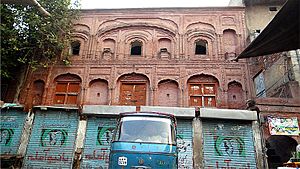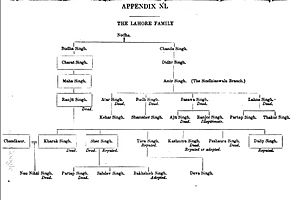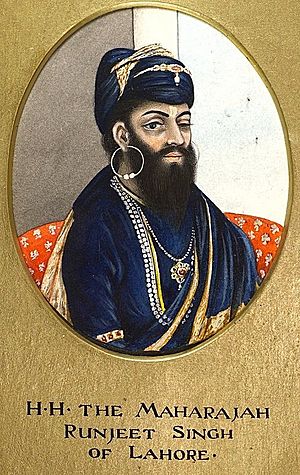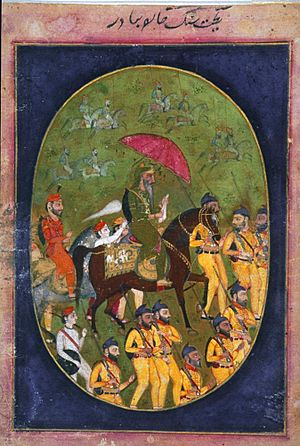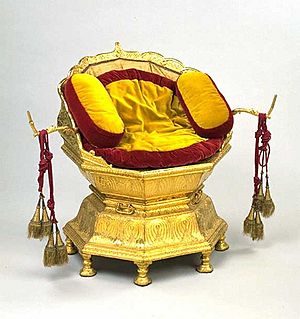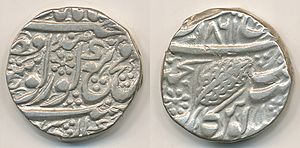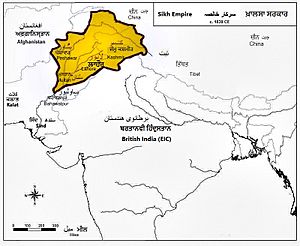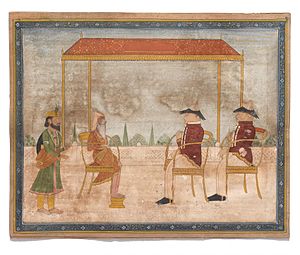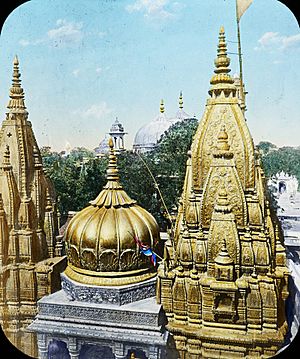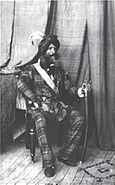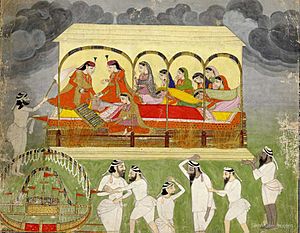Ranjit Singh facts for kids
Quick facts for kids Ranjit Singh |
|
|---|---|
| Maharaja of Punjab Maharaja of Lahore Sher-e-Punjab (Lion of Punjab) Sher-e-Hind (Lion of Hind) Sarkar-i-Wallah (Head of State) Sarkar Khalsaji (Head of State) Lord of Five Rivers Singh Sahib |
|
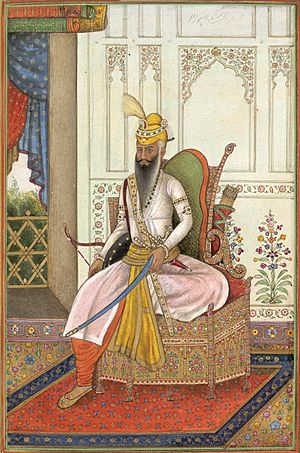
Maharaja Ranjit Singh
|
|
| 1st Maharaja of the Sikh Empire | |
| Reign | 12 April 1801 – 27 June 1839 |
| Investiture | 12 April 1801 at Lahore Fort |
| Successor | Maharaja Kharak Singh |
| 3rd Chief of Sukerchakia Misl | |
| Reign | April 1792 – 11 April 1801 |
| Predecessor | Maha Singh |
| Born | Buddh Singh 13 November 1780 Gujranwala, Sukerchakia Misl, Sikh Confederacy (present-day Punjab, Pakistan) |
| Died | 27 June 1839 (aged 58) Lahore, Sikh Empire (present-day Punjab, Pakistan) |
| Burial | Cremated remains stored in the Samadhi of Ranjit Singh, Lahore |
| Spouse | Maharani Mehtab Kaur Maharani Datar Kaur Maharani Jind Kaur |
| Issue | Maharaja Kharak Singh Ishar Singh Rattan Singh Maharaja Sher Singh Tara Singh Fateh Singh Multana Singh Kashmira Singh Peshaura Singh Maharaja Duleep Singh |
| Father | Sardar Maha Singh |
| Mother | Raj Kaur |
| Religion | Sikhism |
| Signature (handprint) | 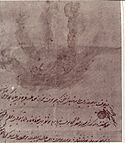 |
Ranjit Singh (born November 13, 1780 – died June 27, 1839) was a powerful leader. People often called him Sher-e-Punjab, which means "Lion of Punjab." He was the very first Maharaja (great king) of the Sikh Empire. This empire ruled a large part of northwest India in the early 1800s.
When he was a baby, Ranjit Singh survived smallpox. However, he lost sight in his left eye. He fought his first battle with his father at just 10 years old. As a teenager, he fought many wars to push back the Afghans. By age 21, he was named the "Maharaja of Punjab."
Under his leadership, the Sikh Empire grew across the Punjab region. Before him, Punjab had many small, warring groups called misls. Ranjit Singh brought these Sikh groups together. He also took over other local kingdoms to create a strong Sikh Empire. He bravely defeated many invasions from Afghanistan. He also made peaceful agreements with the British.
Ranjit Singh's rule brought many good changes. He modernized his army and invested in new buildings and roads. His empire became very prosperous. His army and government included Sikhs, Hindus, Muslims, and even Europeans. He also supported Sikh culture and art. He helped rebuild the Harmandir Sahib (Golden Temple) in Amritsar. He also helped build other important Sikh temples. His son, Kharak Singh, became Maharaja after him.
In 2020, Ranjit Singh was voted the "Greatest Leader of All Time" in a poll. This poll was done by 'BBC World Histories Magazine'.
Contents
Early Life and Challenges
Ranjit Singh was born on November 13, 1780. His parents were Maha Singh and Raj Kaur. He was born in Gujranwala, in the Punjab region. This area is now in Punjab, Pakistan. His mother, Raj Kaur, was the daughter of Raja Gajpat Singh of Jind.
He was first named Buddh Singh. But his father changed his name to Ranjit Singh. "Ranjit" means "victor in battle," and "Singh" means "lion." This name celebrated his father's army winning a battle.
As a baby, Ranjit Singh got smallpox. This illness caused him to lose sight in his left eye. It also left marks on his face. He was not very tall and never went to school. He did not learn to read or write much. However, he was trained at home in important skills. These included horse riding, shooting, and other fighting arts.
When he was 12, his father passed away. Ranjit Singh then took over his father's lands. His mother, Raj Kaur, helped him manage everything. His mother passed away when he was 18. After this, his first wife's mother helped him.
Ranjit Singh had some strict rules for his court. He did not smoke or eat beef. He also required all his officials to follow these rules. This was true no matter their religion.
Family Life
Ranjit Singh had several important marriages. His first wife was Mehtab Kaur. Their marriage was arranged to bring peace between warring Sikh groups. Mehtab Kaur had three sons: Ishar Singh, Sher Singh, and Tara Singh. She passed away in 1813.
His second wife was Datar Kaur. She was also known as Raj Kaur. This marriage was a happy one for Ranjit Singh. He always treated her with great respect. She gave birth to his eldest son and future heir, Kharak Singh, in 1801. Datar Kaur also had two other sons: Rattan Singh and Fateh Singh. She was very smart and helped him with state matters. She even helped lead an army during a battle in 1818. Ranjit Singh called her Mai Nakain with affection. She was his main wife and chief queen.
Ranjit Singh also married Jind Kaur later in his life. She gave birth to his youngest son, Duleep Singh, in 1838. Duleep Singh later became the last Maharaja of the Sikh Empire.
Sons of Ranjit Singh
Ranjit Singh had several sons who played roles in the empire:
- Kharak Singh (born 1801) was his eldest son. He was born to his favorite wife, Datar Kaur. Kharak Singh became Maharaja after his father.
- Ishar Singh was the son of his first wife, Mehtab Kaur. He passed away as a baby in 1805.
- Rattan Singh (born 1805) was also a son of Datar Kaur.
- Sher Singh (born 1807) was one of the twins born to Mehtab Kaur. He briefly became Maharaja later on.
- Tara Singh (born 1807) was the other twin born to Mehtab Kaur.
- Multana Singh (born 1819) was a son born to Ratan Kaur.
- Kashmira Singh (born 1821) was a son born to Daya Kaur.
- Pashaura Singh (born 1821) was also a son born to Daya Kaur.
- Duleep Singh (born 1838) was Ranjit Singh's youngest son. He was the only child of Jind Kaur. He became the last Maharaja of the Sikh Empire.
Punishment by Religious Leaders
In 1802, Ranjit Singh married Moran Sarkar, a Muslim dancer. This action, along with other choices, upset some strict Sikhs. These included the Nihangs, led by Akali Phula Singh. Akali Phula Singh was the leader of the Akal Takht, a very important Sikh religious authority.
When Ranjit Singh visited Amritsar, he was called to the Akal Takht. He had to apologize for his actions. Akali Phula Singh prepared to punish him. But then he asked the Sikh pilgrims nearby if they accepted Ranjit Singh's apology. The pilgrims agreed, and Ranjit Singh was forgiven.
Building the Sikh Empire
How the Empire Began
After the death of Aurangzeb in 1707, the Mughal Empire became weak. It lost control over much of India. In Punjab, the Sikh warrior community, called the Khalsa, grew stronger. They resisted attacks from Afghans. Sikhs also started collecting taxes, which helped their warriors.
By the late 1700s, northwest India had many small, fighting regions. Twelve of these were Sikh-controlled groups called misls. One area was Muslim-controlled, and another was led by an Englishman. These regions were in the fertile land of five rivers: Jhelum, Chenab, Ravi, Bias, and Sutlej. The Sikh misls were all part of the Khalsa. But they often fought each other over money and local issues. However, they usually united when outside armies, like those from Afghanistan, invaded.
Ranjit Singh belonged to one of the most powerful misls, the Sukkarchakkia. He formed strong alliances with other powerful Sikh groups through marriage.
Military Victories
Early Successes
Ranjit Singh became famous in 1797, when he was 17. The Afghan ruler, Shah Zaman, tried to take over Punjab. Ranjit Singh's knowledge of the land and his fighting skills helped him defeat the Afghan army. This victory made him well-known. In 1798, the Afghan ruler sent another army. Ranjit Singh let them enter Lahore. Then, he surrounded them and cut off their food and supplies. He also burned any crops that could feed the Afghan army. This forced most of the Afghan army to retreat.
In 1799, Ranjit Singh's army, with help from his mother-in-law's forces, attacked Lahore. The rulers there fled. This was Ranjit Singh's first big conquest. In 1800, the ruler of Jammu also gave his region to Ranjit Singh.
In 1801, Ranjit Singh declared himself the "Maharaja of Punjab." A Sikh religious leader performed his coronation ceremony. On that day, prayers were said in mosques, temples, and Sikh temples for his long life. Ranjit Singh called his rule "Sarkar Khalsa" (Government of the Khalsa). He also ordered new coins to be made in the name of Guru Nanak.
Expanding the Empire
In 1802, Ranjit Singh, at age 22, took Amritsar from another Sikh group. He visited the Harmandir Sahib (Golden Temple). This temple had been damaged by Afghan invaders. Ranjit Singh promised to rebuild it with marble and gold.
On January 1, 1806, Ranjit Singh signed a treaty with the British. He agreed not to expand his forces south of the Sutlej river. The British agreed not to cross the Sutlej into Sikh land.
In 1807, Ranjit Singh's forces attacked Kasur, which was ruled by Muslims. After a tough fight, he defeated the Afghan chief. This expanded his empire towards Afghanistan. He took Multan in 1818. In 1819, he defeated the Afghan rulers in Srinagar and Kashmir. This stretched his rule into the Himalayas.
The Sikhs and Afghans fought several important battles. In 1813, Ranjit Singh's general defeated Afghan forces at Attock. In 1818, Sikh forces took Multan, ending Afghan influence in Punjab. In 1819, the Sikh army took Kashmir.
In 1823, Pashtun tribes fought Ranjit Singh's army. In 1834, another Afghan army marched towards Peshawar. Ranjit Singh defeated them. The Battle of Jamrud in 1837 was the last major fight between Sikhs and Afghans. It showed how far west the Sikh Empire reached.
In 1838, Ranjit Singh agreed to a treaty with the British. They worked together to put Shah Shoja back on the Afghan throne. The British army entered Afghanistan from the south. Ranjit Singh's troops went through the Khyber Pass. They took part in the victory parade in Kabul.
Where the Sikh Empire Was
The Sikh Empire was in the Punjab region. "Punjab" means "land of the five rivers." These rivers are the Beas, Ravi, Sutlej, Chenab, and Jhelum. All of them flow into the Indus River.
Under Ranjit Singh, the Sikh Empire covered all lands north of the Sutlej river. It also reached south of the high valleys of the Himalayas. Important cities in his empire included Srinagar, Attock, Peshawar, Lahore, and Multan.
About 70% of the people in his kingdom were Muslims. About 24% were Hindus, and 6-7% were Sikhs.
How He Governed
Ranjit Singh allowed people of all religions and backgrounds to serve in his army and government. His army included Sikhs, Hindus, Muslims, and Europeans. He had a few European officers, like Jean-François Allard from France. However, he avoided hiring British officers. He knew the British wanted to control India.
He kept good relations with the British. In 1828, he sent gifts to King George IV. In 1831, he sent a group to meet the British Governor General. In 1838, he worked with them against an Afghan ruler.
Religious Tolerance
Ranjit Singh was a fair ruler who respected all religions. He was a devoted Sikh. He restored and built important Sikh temples, especially the Harmandir Sahib (Golden Temple). He often gave thanks at the Harmandir after his victories. He also visited Hindu temples to show respect. Killing cows was against the law and punishable by death. He told his soldiers not to harm or rob civilians.
He built several Sikh temples, Hindu temples, and even mosques. One mosque was built for his Muslim wife, Moran Sarkar. Sikhs under Singh never destroyed enemy places of worship. However, some Muslim mosques were used for other purposes by his army. For example, Lahore's Badshahi Mosque was used to store ammunition and horses. But he also restored some mosques when asked.
Ranjit Singh's court had people from different religions. His prime minister was a Dogra (Hindu). His foreign minister was a Muslim. His finance minister was a Brahmin (Hindu). Artillery commanders were also Muslims. No one was forced to change their religion. His wives, including his Muslim and Hindu wives, kept their own faiths.
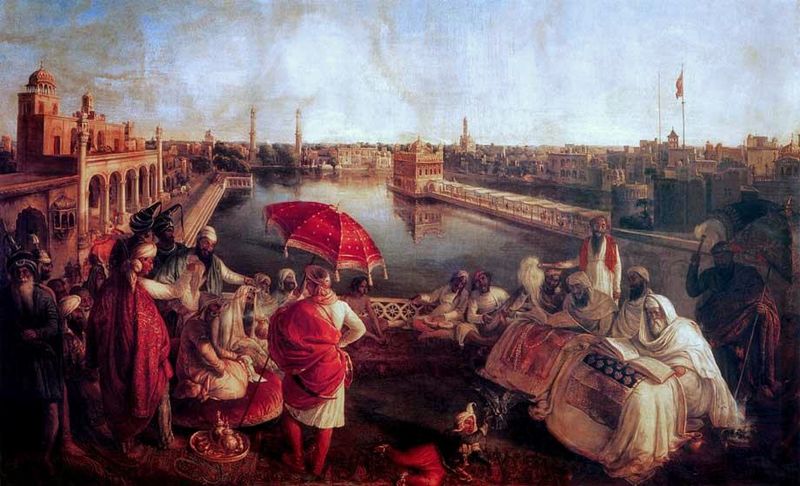
Administration and Army
The Khalsa Army
Ranjit Singh's army, called the Khalsa Army, was not just for Sikhs. It included soldiers and officers who were Sikhs, Hindus, Muslims, and Europeans. His government also had people from different religions. He even had Polish, Russian, Spanish, Prussian, and French officers.
As his army grew, he added more Rajput and Jat Sikhs. They became the main part of his army. In some areas, his army had more Hindu Rajputs. Near Afghanistan, more Muslims served in his army.
Army Improvements

Ranjit Singh greatly improved his army's training and organization. He made changes to how troops were moved and how they fought. He focused on steady gunfire instead of just cavalry attacks. He also improved their weapons and fighting methods. His military system combined the best of old and new ideas. He made his infantry (foot soldiers) and artillery (cannons) stronger. He paid his soldiers directly from the government treasury. This was different from the old system where local lords paid soldiers.
Ranjit Singh made sure Punjab could make all the weapons and supplies his army needed. His government invested in factories for cannons, gunpowder, and arms. Some of these were state-owned, and others were private.
However, Ranjit Singh did not invest much in other things like irrigation canals or roads. The wealth in his empire came mostly from better security and trade.
Death and Lasting Impact
His Passing
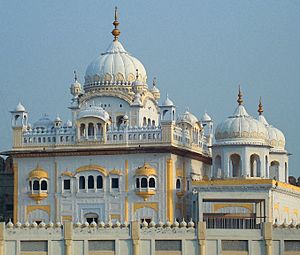
In the 1830s, Ranjit Singh became very ill. He suffered a stroke and had liver problems. He passed away peacefully in his sleep on June 27, 1839. After his death, some of his wives and other women followed the tradition of sati. This meant they voluntarily joined his funeral pyre as a sign of devotion.
Ranjit Singh is remembered for uniting the Sikhs. He founded the successful Sikh Empire. He is also known for his military victories. He built a strong, well-trained army to protect his empire. He gathered great wealth, including the famous Koh-i-Noor diamond. He left this diamond to a temple in India.
Important Sikh Temples
Perhaps Ranjit Singh's greatest legacy was restoring and expanding the Harmandir Sahib. This is the most sacred Sikh temple, now known as the "Golden Temple." He paid for much of its beautiful gold and marble work. He also funded protective walls and a water system for the temple. He also ordered the building of two other very sacred Sikh temples. These were the birthplaces and places of death of Guru Gobind Singh.

Memorials and Museums
- The Samadhi of Ranjit Singh in Lahore, Pakistan, is where he was cremated.
- On August 20, 2003, a 22-foot-tall bronze statue of Singh was placed in the Parliament of India.
- A museum at Ram Bagh Palace in Amritsar has items related to Singh. These include weapons, paintings, coins, and jewelry.
- On June 27, 2019, a nine-foot bronze statue of Singh was unveiled at the Lahore Fort. This was on his 180th death anniversary.
Crafts He Supported
In 1783, Ranjit Singh started a crafts colony near Amritsar. He encouraged skilled metalworkers from Kashmir to settle there. These crafters, called Thatheras, made brass and copper products. In 2014, this traditional craft was added to the UNESCO List of Intangible Cultural Heritage.
See also
 In Spanish: Ranjit Singh para niños
In Spanish: Ranjit Singh para niños
- Baradari of Ranjit Singh
- History of Punjab
- Charat Singh
- Hari Singh Nalwa
- List of generals of Ranjit Singh
- Koh-i-Noor
- Battle of Balakot


